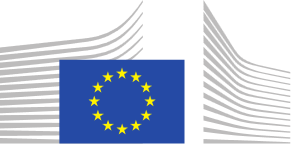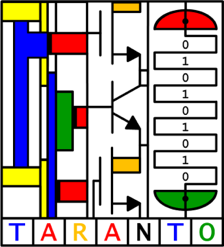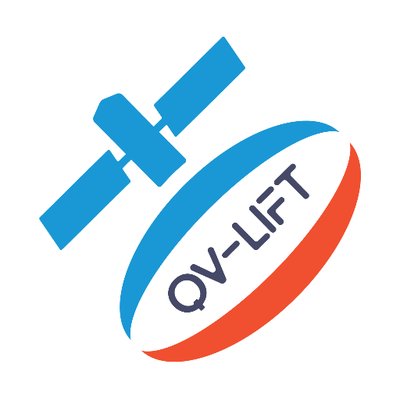This page contains a summary of the most relevant completed projects.
├ FLEXCOM
Objective
FLEXCOM aims at building a new class of phased arrays technology for airborne, spaceborne, and Earth segment satellite communications with an unpreceded level of flexibility and reconfigurability. Precisely, FLEXCOM will deliver a highly integrated antenna tile conceived to be the building block through which several SatCom antenna types can be built. The FLEXCOM tiles are designed to be used in different scenarios and for different applications, responding to the needs of a continuously evolving SatCom market and enforcing a significant reduction of life-cycle costs.
The developed tiles will provide:
• Broadband TX/RX operations at K/Ka-band in a single radiating aperture;
• Possibility to adopt two different beamforming cores, namely Hybrid Analog/Digital beamforming or, for the first time for K-Ka SatCom applications, fully-digital beamforming with direct conversion;
• Electronic steering, multibeam and smart antennas functionalities.
FLEXCOM will develop and integrate into each tile the following beyond the state-of-the-art subsystems:
TX/RX K/Ka band Analog Front Ends (AFE) based on multicore SiGeBiCMOS RFICs, including phase shifters and down conversion stages;
• A Digital Beamforming processor dedicated to SatCom applications;
• Dual-band radiating apertures covering K/Ka SatCom and 5G bands.
The FLEXCOM technology will be demonstrated by building and testing three prototypes relevant to real use cases:
• a prototype for the Internet of Things and Machine to Machine applications;
• a conformal integrated on a UAV platform;
• a feed for a transmit array, intended for High Altitude Platform application.
FLEXCOM will contribute to the development of the European research and technology ecosystem combining in the consortium, a robust industrial partnership covering both the SatCom (THALES and TTI) and the 5G network (NOKIA and SIAE) area as well as key players in the supply chain (TE2V, ANTECNICA, and EVATRONIX). This partnership will include two academic institutions (CNIT-UNICAL, ULM) and a research center (IHP).
Related publications

Partners
- CNIT-UNIVERSITA’ DELLA CALABRIA, Italy
- UNIVERSITAET ULM, Germany
- IHP Microelectronics, Germany
- SIAE Microelettronica, Italy
- NOKIA, DE
- THALES, France
- TTI, Spain
- TE2V, France
- Evatronix, Poland
- Antecnica, Italy
Funding
EU-H2020-LEIT-Space
2020-2024

Project website
https://www.flexcom-h2020.eu/
├ FLEXWIN
Objective
FLEXWIN proposes a significant advance towards smart RF microsystems by combining 1.) an RFMEMS switch process monolithically integrated with a Si/SiGe BiCMOS process, 2.) highly reconfigurable mm-wave building blocks, able to be used over a broad frequency range and for different applications, 3.) a new RF-system design paradigm built around the concepts of reusability, multifunctionality and reconfigurability and 4.) environmental sensing and control built into multifunctional RF ICs with digital control.As a first demonstrator of the proposed highly innovative FLEXWIN technology platform, a smart reflectarray architecture for broadband communication links will be realized. In fact, the core FLEXWIN ICs will be used as intelligent pixels providing spatial power combining with full individual amplitude and phase settings of each pixel in transmit and receive mode controlled by a serial bus. Together with the monolithic integration of the environmental sensors on the very same IC, it dramatically reduces the antennas control system complexity providing significant advances in RF frontend adaptability.The validity of the design paradigm will be further explored in two reconfigurable IC demonstrators using the RF MEMS SiGe BiCMOS technology and deliberately spaced in the radio spectrum: reconfigurable “commodity” building blocks up to 5 GHz, addressing mobile and wireless data applications, and for the 30-64 GHz range, addressing point-to-point, and emerging wireless LAN applications.Overall, FLEXWIN will demonstrate enhanced and smart capabilities of mm-wave systems due to built-in intelligence allowing convenient and flexible control of important parameters, and the use in harsh environments due to built-in sensing and autonomous parameter adjustment in each module. Further, it will establish reconfigurable multi-functional millimetre-wave ICs as an off-the-shelf commodity which will ease mm-wave system implementation and shorten the time-to-market.
Related publications
[1] A. Shamsafar et al., «A Four-Port SiGe BiCMOS Duplexer for Ka-Band SatCom on the Move User Terminals», IEEE Microwave and Wireless Components Letters, vol. 25, n. 11, pagg. 733–735, 2015, doi: 10.1109/LMWC.2015.2479854.[2] A. I. Sandhu, E. Arnieri, G. Amendola, L. Boccia, E. Meniconi, e V. Ziegler, «Radiating Elements for Shared Aperture Tx/Rx Phased Arrays at K/Ka Band», IEEE Transactions on Antennas and Propagation, vol. 64, n. 6, pagg. 2270–2282, 2016, doi: 10.1109/TAP.2016.2552550.[3] F. Tabarani, L. Boccia, T. Purtova, A. Shamsafar, H. Schumacher, e G. Amendola, «0.25-um SiGe BiCMOS System-on-Chip for K-/Ka-Band Satellite Communication Transmit–Receive Active Phased Arrays», IEEE Transactions on Microwave Theory and Techniques, vol. 66, n. 5, pagg. 2325–2339, mag. 2018, doi: 10.1109/TMTT.2017.2774804.

Partners
- Airbus Defence and Space GmbH
- UNIVERSITA’ DELLA CALABRIA, Italy
- UNIVERSITY OF SURREY, UK
- UNIVERSITAET ULM, Germany
- MIPOT SPA, Italy
- ERICSSON AB, Sweden
- IHP Microelectronics, Germany
Funding
EU-FP7-ICT – Specific Programme “Cooperation”: Information and communication technologies
2010-2014

Project website
├ DIFFERENT
Objective
DIFFERENT aims at building the foundation of a new generation of space-borne Synthetic Aperture Radars (SAR) with a significant reduction in cost, size, mass and power consumption, and enhanced performances with respect to systems currently available. The final product will be a compact, dual-band, dual-polarization radar with DBF capabilities. DIFFERENT will achieve these results setting up a consortium between SMEs and research institutions to develop and to exchange technologies and know how to improve competitiveness of SMEs.
1) DIFFERENT proposes advances towards space-borne radars building a low-cost, compact SAR by combining
a) a new concept of multi-static dual-band (Ka/X) dual-polarization passive SAR having digital beamforming (DBF);
b) the development of DBF BICMOS chip and of SiGe MMIC to enhance radar operations and to allow an unprecedented level of integration;
c) the development of a dual-band (Ka/X) dual-polarized low-cost array antenna which will have a shared apertur;
d) integration technologies that will make use of materials new to the space sector and that will ensure the high level of integration to reduce costs and weight of the overall payload.
2) DIFFERENT targets the stable integration of SMEs into the Earth Observation (EO) value chain by developing know how in the following key areas which are recognized as strategic for the future scientific and commercial missions
a. SiGe BiCMOS integrated circuits
b. Advanced integration techniques
c. Digital Beam Forming
3) DIFFERENT will open to SMEs new possibilities in the entire space sector developing a distributed SAR space system fulfilling governmental and commercial needs.
4) The DIFFERENT consortium is tailored to sustain the involved SMEs towards the acquisition of a leading role in the EO value chain. SMEs central position in DIFFERENT is supported by a national space agency (DLR), by a research institute and technology provider (IHP) and by two academic partners (UNICAL / KENT)
Related publications

Partners
- Silicon Radar, DE
- DLR, DE
- IHP Microelectronics, Germany
- Evatronix, Poland
-
University of Calabria, IT
-
UNIVERSITY OF KENT, UK
Funding
FP7-SPACE-2013-1
2013-2018

Project website
├ TARANTO
Objective
TowARds Advanced bicmos NanoTechnology platforms for rf and thz applicatiOns (TARANTO) targets to break the technological barriers to the development of the next BiCMOS technology platforms, allowing the improvement of the performance of the HBT (Heterojunction Bipolar Transistors) with a much higher level of integration. This new generation of transistors HBT will be a key factor to meet the needs of high-speed communications systems and high data rate required for the integration of heterogeneous intelligent systems as well as for intelligent mobility systems that will be used in future fully automated transport systems. The main objectives of this project will be to develop transistors HBT offering high maximum frequency (Fmax: 600GHz) built to very high density CMOS processes: 130 / 90nm for IFX, 55 / 28nm to ST, while IHP will work on the project to achieve maximum frequencies of 700GHz remaining compatible with IFX and ST BiCMOS processes.
The project consortium gathers the main European players in the value chain for these applications at very high frequencies, from laboratories to industrial users, thus ensuring the highest scientific level and the ability to validate the work carried out on appropriate demonstrators.
Related publications

Partners
Funding
H2020-EU.2.1.1.7. – ECSEL
2017-2021

Project website
http://tima.univ-grenoble-alpes.fr/taranto/
https://cordis.europa.eu/project/id/737454/it
├ QV LIFT
Objective
QV-LIFT is a Horizon2020 Research & Innovation Action (Call: Leadership in Enabling and Industrial Technologies – Space COMPET-2-2016) committed to increase the maturity level of key satellite communication technologies and to contribute to a more competitive positioning of SatCom European manufacturers in the marketplace.

QV-LIFT smart gateway network (QV-SGN) relies upon existing assets: the satellite link from/to Alphasat and upon Earth Station 1 operating in Tito Scalo (Italy) and Earth Station 3 operating in Spino d’Adda (Italy) both made available by ASI and the STARFISH gateway SW/HW made available by MBI.
QV-LIFT will develop and integrate the following subsystems: Earth Station 2, the mobile airborne terminal, the smart gateway management system.
The QV-LIFT project aims at developing the foundation of the Ground Segment Technology for the future Q/V band Terabit SatCom systems by providing core technologies at both hardware and network levels of the communication stack.
At hardware level, key RF building blocks and subsystems in the Q/V band will be developed that will fill a specific and well known European technology gap; at network level, QV-LIFT will develop a Q/V band smart gateways management system able to counteract the propagation impairments which presents one of the main obstacles in the deployment of the Q/V band feeders system.
Hardware and network developments will be demonstrated in a unique and realistic test environment where a mobile Q/V band terminal and three Earth stations will be linked to the Alphasat payload to create the QV-LIFT smart gateway network.

Partners
- Agenzia Spaziale Italiana
- Consorzio Nazionale Interuniversitario per le Telecomunicazioni
- Martel GmbH
- Erzia technologies S.L.
- Eutelsat S.A
- M.B.I. S.R.L.
- Heriot-Watt University
- Skytech Italia S.R.L.
- Ommic SAS
Funding
EU-H2020-LEIT-Space
2020-2023

Project website
├ OT4 Clima
Objective
L’obiettivo generale del progetto OT4CLIMA è quello di sviluppare nuovi strumenti di misura e nuove metodologie di Osservazione della Terra per fornire prodotti/applicazioni/servizi volti a migliorare le capacità di mitigazione degli effetti dei Cambiamenti Climatici (CC) alla scala regionale e sub-regionale.
Il progetto nasce dalla consapevolezza che gli impatti dei CC in atto sull’ambiente ed il territorio necessitano di essere meglio compresi, modellati ed osservati, anche alla scala locale e regionale al fine di porre in essere strategie di mitigazione appropriate ed efficaci. Esso prova a rispondere ad alcune delle sfide ancora aperte, individuate dalle principali iniziative internazionali (e.g CEOS WG Climate, GCOS) come Raccomandazioni ed Azioni per i prossimi anni come, ad esempio, l’utilizzo di nuove tecnologie di osservazione, l’osservazione di parametri climatici aggiuntivi nonché lo sviluppo di nuove tecniche di analisi (cfr. GCOS 2016 Implementation Plan).
OT4CLIMA, senza avere la pretesa di affrontare la problematica nel suo complesso, intende contribuire su specifici ambiti fenomenologici (ciclo dell’acqua e ciclo del Carbonio), parametri, osservabili e matrici ambientali.
Verranno in particolare studiati sia gli impatti a medio-lungo termine (es. stress vegetazionali, siccità) sia gli eventi estremi con dinamica evolutiva rapida (es. fenomeni meteorologici intensi, incendi) tentando una duplice innovazione tecnologica, di “prodotto” e di “processo”.
Il progetto, per esempio, renderà concreta la possibilità di misurare, con modalità e accuratezza senza precedenti, parametri atmosferici (per es. l’OCS, solfuro di carbonile) e superficiali (per es. il contenuto d’acqua dei suoli) cruciali nella determinazione del contributo della vegetazione al bilancio della CO2, proponendo al contempo soluzioni, basate sull’analisi e l’integrazione di dati osservativi acquisiti da piattaforme satellitari, avio-trasportate ed unmanned, per migliorare significativamente la capacità delle comunità locali di affrontare gli effetti dei CC a breve e lungo termine.
Il team di progetto è costituito da una solida partnership pubblico-privata con una forte presenza nel sistema della ricerca e dell’innovazione europeo e nazionale nel settore dell’Aerospazio.
Committente: Ministero dell’Istruzione, Università e Ricerca (MIUR)
Coordinatore: Consiglio Nazionale delle Ricerche
Responsabile scientifico: Nicola Pergola (CNR-IMAA)
Periodo di attività: 2018 -2021
Costo totale progetto: € 9.049.470,47
Agevolazione complessiva: € 4.494.621,38
Related publications

Partners
- Consiglio Nazionale delle Ricerche (CNR), (coordinatore) attraverso i seguenti Istituti: IMAA, IREA, ISAC, INO, IFAC, IRPI, IGG,
IRET, IMM, ISAFOM, IBIMET, IAC, IIA, SPIN;
Università della Basilicata (UNIBAS);
Università della Calabria (UNICAL);
Università di Trento (UNITN);
Agenzia Spaziale Italiana (ASI);
Istituto Nazionale di Geofisica e Vulcanologia (INGV)
Funding
PON

Project website
http://www.ponricerca.gov.it/
